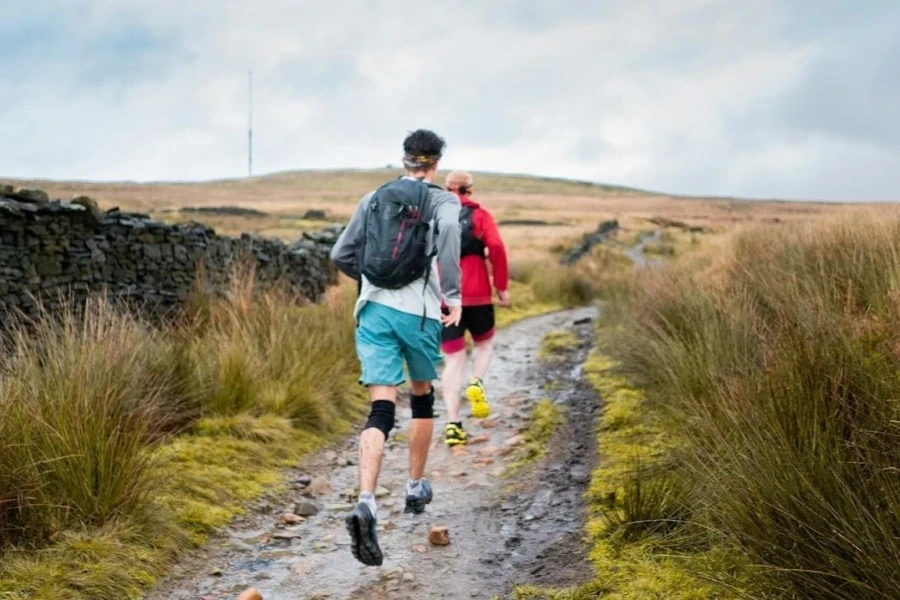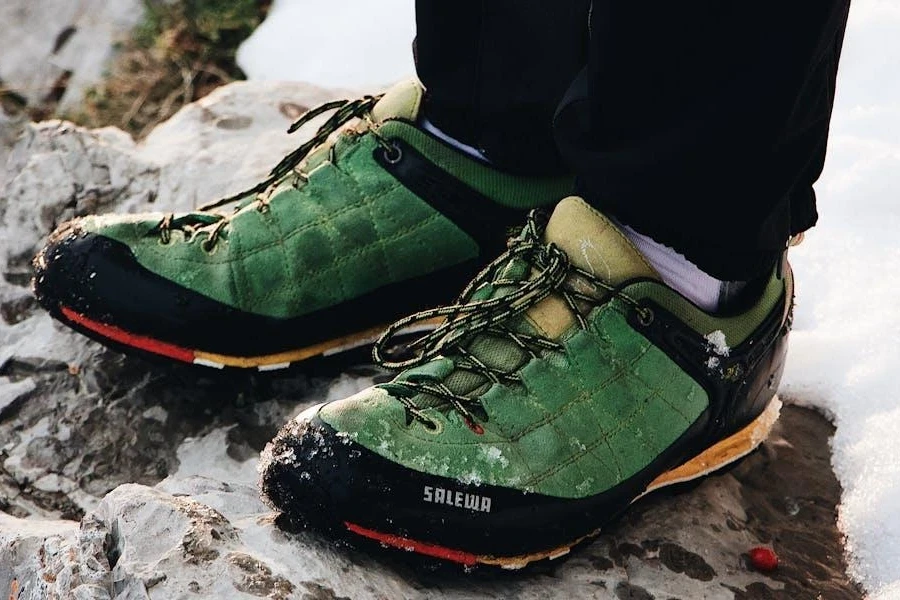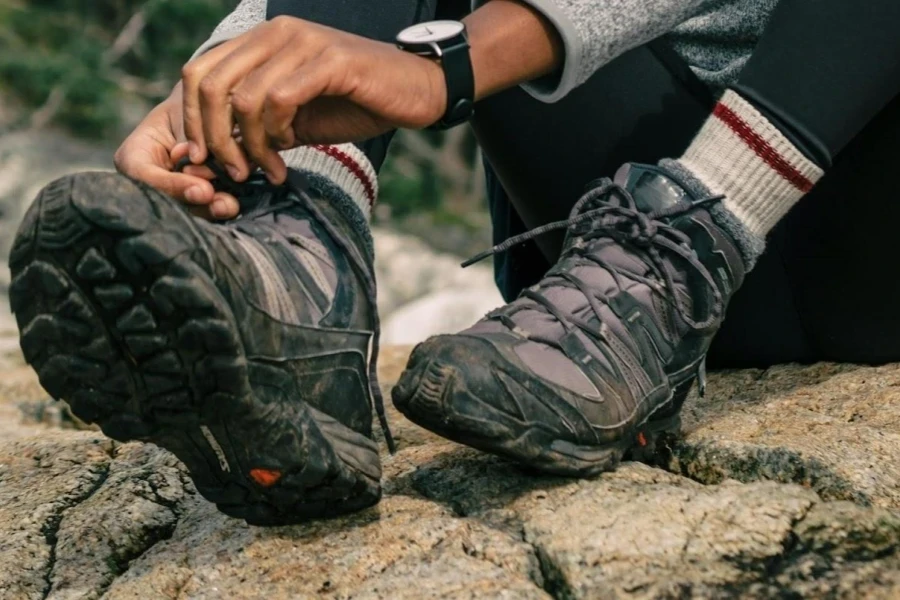Hiking and trail running involve one common thing: engaging the feet in a lot of work. Since consumers will spend a lot of time on their feet, it only makes sense that they seriously consider their footwear options. Naturally, it often comes down to two options: trail running vs. hiking shoes.
Choosing between these shoes depends on where and how long consumers will be hiking, shoe tread, waterproofness, and breathability. This article will compare trail running and hiking shoes to help retailers determine which one to offer consumers for their outdoor needs.
Table of Contents
What are trail running shoes, and how popular are they?
What are hiking shoes, and how popular are they?
Trail running vs. hiking shoes: What are the key differences
4 questions to ask when choosing between trail running and hiking shoes
Bottom line
What are trail running shoes, and how popular are they?

Contrary to the name, consumers don’t have to be trail runners to enjoy the benefits of trail running shoes. Manufacturers design them to handle more technical and rugged surfaces than paved roads. Beyond that, they also have some variety regarding design and style (which will be discussed in more detail below).
Trail running shoes registered an impressive rise in search interest in 2024. According to Google ads data, they started 2024 with 74,000 searches in January. Then, they boosted to 90,500 searches in February and March, 110,000 in April and May, and 135,000 in June and July.
What are hiking shoes, and how popular are they?

Hiking shoes are the saviors for all kinds of rugged terrains. They are more stable, durable, and packed with many protective features, ensuring consumers have the best hiking experience possible. Some hiking shoes come with complete ankle protection (like boots), while others don’t for the more casual treks.
Google data shows hiking shoes registered a massive surge in earlier months of 2024. Search interest boosted to 40.9 million searches in March and 27.4 million in April 2024. However, searches dropped to 301,000 in May before increasing to 368,000 monthly in June and July 2024.
Trail running shoes vs. hiking shoes: What are the key differences
1. Construction
Although trail running shoes are heavier and more reinforced than road running shoes, they still feature lightweight materials. Manufacturers often make them from natural or synthetic leather and waterproof membranes, making them feel lighter on the wearer’s feet. Trail running shoes are also minimalist, perfect for faster-paced and shorter hikes.
Meanwhile, hiking shoes are heavier because they have many features. These shoes have natural or synthetic leather uppers, waterproof membranes, strong rubber outsoles, and protective reinforcements. Consumers will get enough foot protection for various technical terrains despite being heavier.
Moreover, hiking shoes often feature the same materials and construction as their boot counterparts. They offer impressive durability and stability, allowing consumers to use them for up to 1,000 miles. Hiking shoes are also the go-to for slower-paced treks.
2. Soles

People who choose trail runner shoes want maximum speed and flexibility. That’s why manufacturers make them with flexible soles, which help consumers enjoy quicker movements. Hikers benefit from this sole design because of the faster turnover than hiking shoes.
Furthermore, trail running shoes get their traction from lugs on their outsoles. Although trail running shoes are not as thick and grippy as their hiking counterparts, they offer enough traction to stabilize consumers during their faster-paced hikes.
Conversely, hiking shoes have stiffer rubber soles, making them denser and more stable than trail running variants. Additionally, these shoes have bigger lugs for supreme grip on different trails. More often than not, hiking shoe soles look similar to their boot cousins.
Equally important, hiking shoes offer supreme traction due to their rubber soles and deep tread. Some manufacturers advertise their shoes with rubber soles for specific purposes or terrains. For instance, some hiking shoes are perfect for muddy hikes, rocky trials, or dusty deserts, while others are better for Class III mountains.
3. Breathability and quick-drying
Trail running shoes have mesh uppers that keep them lightweight and breathable. Since consumers will be moving faster in these kicks, their feet will overheat faster. Trail running shoes can help them regulate that temperature for a more comfortable experience.
In addition, the mesh upper means water vulnerability, which may lead to blisters during a trail run. To counter this, manufacturers make trail running shoes from quick-drying materials. Contrarily, hiking shoes are less flexible and breathable because of their thicker construction.
Some trail running shoes sacrifice breathability for waterproofing. These models appeal to people who trek or trail run frequently in snowy or wet conditions.
4. Surface compatibility

Trail running shoes are the kings of adaptability. Manufacturers design them to handle different surfaces, including gravel, dirt, rocks, and mud. Trail running shoes gain the upper hand for their lighter and more flexible designs, allowing consumers to enjoy quicker adaptation and better agility on different surfaces.
Although hiking shoes can handle those surfaces, their designs make them better equipped for slick, uneven, and rocky terrains.
5. Break in period
Another significant advantage of trail running shoes is their shorter break-in times. Their cushioned soles and lightweight build make it easier for consumers to enjoy longer adventures without the notorious foot pain of new shoes. Conversely, hiking shoes take longer to break in because of their tougher and stiffer materials.
6. Versatility
Trail running shoes are great at what manufacturers designed them for trail running. However, they can also handle some hiking in most conditions, especially when consumers don’t mind the lower protection and stability. These conditions often include less muddy or snowy terrains and when consumers want long hiking adventures without tired feet.
Hiking shoes are less versatile. Their designs are ideal for slow-paced hiking adventures. But anything faster than that would be tiring and possibly cause problems for the wearer’s feet.
7. Lifespan

Trail running shoes are less durable than hiking variants, so they have shorter lifespans. Depending on the quality and how consumers use them, trail running shoes can last up to 500 miles. On the other hand, hiking shoes can accompany wearers up to a thousand miles.
4 questions to ask when choosing between trail running and hiking shoes

1. Are consumers new to hiking?
Less experienced hikers will need all the support they can get. Hiking shoes offer more ankle support and stability, so offering them a comfortable pair will keep these novices confident and steady. They may go for trail running shoes and go on shorter, faster hikes as they advance.
2. What is their preferred weather, season, and trail?
Many hikers prefer hiking shoes for better protection when tackling wet or wintery conditions. More importantly, hiking shoes may have different treads based on the target terrain. For instance, they may have softer or harder rubber with larger or lighter lugs. Generally, if consumers worry about trail traction, hiking shoes will be better than trail runners.
3. How fast do they hike?
If consumers want to speed through their trails faster, they will have a better experience with trail running shoes. Conversely, hiking shoes are better for hikers who prefer the slower trek experience.
4. Will they carry a heavy backpack?
Business buyers must consider two things here. First, heavier packs mean hikers may prefer the stability of hiking shoes. Second, hiking shoes are heavier, so hikers may tire out quicker with huge packs.
Retailers can offer hiking shoes if target consumers worry their heavy backpacks will reduce their stability. On the other hand, consumers who worry more about fatigue will feel lighter and more agile with trail running shoes.
Bottom line
Choosing between trail running and hiking shoes depends on the target consumer’s outdoor needs. Retailers should offer trail running shoes if the target consumer wants breathable and lightweight options. However, hiking shoes are the go-to if the consumer prefers stability over flexibility.
Interestingly, the reverse is also the case here. Retailers can also find lightweight day hike shoes with mesh uppers, breathability, and excellent stability. Similarly, they can offer high-top, off-trail style trail running shoes akin to hiking boots.
Want more insightful topics like this? Subscribe to Alibaba Reads Sports Section to stay up-to-date with the latest articles and guides.




